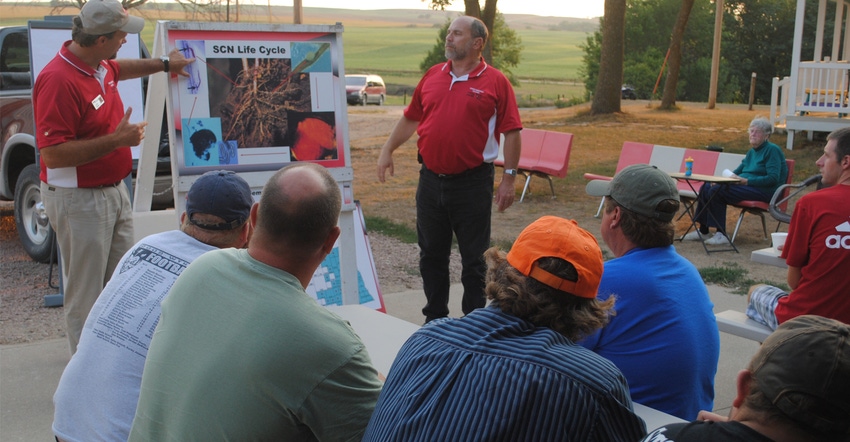
If your fields are infested with soybean cyst nematode, it might be worth your time to assess the winter annual weeds you have growing in your fields this spring. Planting resistant varieties always has been the top recommendation from crop researchers, but controlling winter annuals also may help.
“Pennycress and henbit can both serve as a host to SCN,” says John Wilson, Nebraska Extension educator and SCN specialist. “Generally, these weeds themselves don’t cause much loss in yield. We don’t know to what extent SCN can reproduce on these weeds, but we recommend that if you have SCN in the field, you should consider a fall burndown herbicide treatment to control pennycress and henbit.”
Winter annuals start their growth in the fall, then usually show up in late March and early April. The presence of these weeds in fields where SCN already exists may allow time for another generation of SCN to reproduce in the spring, especially in later planted soybeans, Wilson explains.
“If you are already conducting a fall burndown treatment for marestail, that will work on pennycress and henbit, too,” he says.
“You can use seed protectants as another tool, especially if farmers are having a problem controlling SCN,” Wilson adds. “But protectants should always be used on SCN-resistant seed varieties and not in the place of resistant varieties.”
Wilson notes that the efficacy of the protectants drops off as the season progresses.
“They don’t last the whole season, and more SCN reproduction takes place, so you might have a buildup later in the growing season,” he adds. “These should be used in combination with resistant varieties when necessary.”
While protectants haven’t given the consistent results researchers would like to see, they may offer another tool to combat SCN under certain circumstances.
First identified in Nebraska in 1986, most of the soybean producing counties in the state now have been confirmed with SCN.
“We’ve processed over 9,000 samples from farmers,” Wilson says. “One third of the samples come back positive for SCN. SCN can cause 30% yield loss with no visible signs on the crop.”
Researchers always have encouraged farmers to test their soybean fields for SCN.
“Nebraska Extension offices have sample bags available for pickup,” Wilson says. “This testing program provides free soil analysis for SCN sponsored by the Nebraska Soybean Board and your soybean checkoff dollars.”
Anytime is fine for testing, but in the fall after harvest may be optimal.
“Fall is the best time to test, because life slows down after harvest,” Wilson says. “You can look at yield maps and spots that didn’t yield as high as they should have or notice fields where soybean yields have leveled off over time, but corn yields continue to increase. If you can’t identify why these spots didn’t yield well or aren’t increasing in yield, SCN could be the cause.
“In those cases, I encourage farmers to take one soil sample from the poor yielding areas in a field and another from areas where yields meet expectations” to compare the two.
There are many factors that might contribute to that situation, but SCN would be one cause to look at.
Learn more by visiting thescncoalition.com or contact your local Nebraska Extension office. You also can call Wilson at 402-374-2929 or email [email protected].
About the Author(s)
You May Also Like






